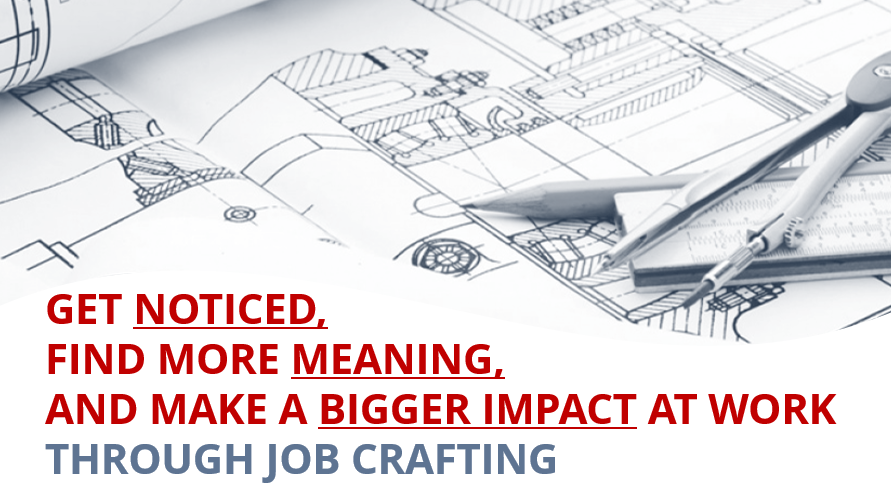This blog is the second in a two-part series discussing ways you can experience more fulfillment at work, without leaving your current job. Click HERE to read part one in the series.
This blog is based on webinar content Stephanie Slocum, our Founder, presented June 12, 2019, in collaboration with SE Impact. The full webinar can be seen in the video below.
Want the implementation exercise referenced in the above video - developed by us, just for engineers - to help you apply this concept to your own career? Sign up for our email list below for access!
When I started my career, I remember being excited to go to work every day. Everything was new, exciting, and there was so much to learn. Although the metrics of success were quite a bit murkier than what I had experienced in school, there was a still a clear metric and goal to achieve: get as much experience in as many areas as I could, so I could pass the professional engineering licensure exam as quickly as possible.
I was working in Pennsylvania at the time. Since PA did not allow me to take the exam a year earlier with a Master’s Degree, I drove to neighboring Ohio to take the exam as soon as I was eligible. As I sat in the exam room, reference books piled next to me, in a room that smelled like a middle-school locker room at a small table and chair that looked just as ancient, I wondered if all the studying I had done would pay off. I also remember thinking “This is it, this is the huge milestone I’ve been working towards since I settled on engineering as my college major.”
When, a few months later, an envelope came in the mail from the testing agency, I tore it open with baited breath. I knew so many engineers that had not passed the first time they took the exam. I let our a sigh of relieve when I read that I had passed. I later found out that this particular exam had about a 40% pass rate in 2007 when I took it.
For a few years afterward, I floated on the euphoria common to a newly minted professional engineers in my field. That certification meant that a raise, a promotion, and many new doors were now open to me not just technically, but also in project and engineering management. It meant I could now supervise my own projects, or even start my own firm if I so desired (which I had no interest in doing at the time).
But, about 2 years after I had earned that certification, that excitement had started to fade.
At first, it happened so slowly as to not be noticeable. I’d hit the snooze button more often, delaying my arrival to work when possible. I found less joy in the technical world of spreadsheets and analysis that I used to get lost in for hours. I found myself feeling like my growth and learning had stagnated, that projects were starting to all look the same, and that my days were on “repeat”, just like that Bill Murray classic movie “Groundhog Day.”
At the time, I didn’t know that this was exactly the same sort of disengagement some 68% of Americans feel at work. All I knew was that I didn’t have the enthusiasm I used to have for my work, and I wasn’t learning and growing in a way fulfilling to me. I wondered what was wrong with me, and I guilty that I had a well-paying job, working with (generally) nice people and clients, yet I still wasn’t satisfied.
“Suck it up,” my inner monologue proclaimed. “This is a problem most people would kill to have, and here you are feeling sorry for yourself. Maybe your expectations are just too high. Maybe this is just the way the real world works.”
Yet that dissatisfaction continued to grow. I knew I could do more, be more, and learn more than my current environment allowed. And I also knew that if I didn’t take charge of the situation, nothing would change.
So, I started thinking about what I really wanted to do, what I really wanted to learn, and where I really wanted to go. It helped that I had a couple of aha’s about the projects I liked to work on, as detailed in the first blog in this series.
But what helped more was that the clarity I found in this soul-searching forced me to become clear on what was sucking my energy at work, and what gave me energy.
It forced me to become much more aware of what constituted a bad day at work, and what made for a great day. Once I became aware of what made for a great day, I strived to do more of those things. In that striving, I started having many less bad days, even if they weren’t all great.
And the cool thing is that I didn’t even need to change employers.
JOB CRAFTING
It turns out that I had accidentally stumbled upon a concept called “job-crafting.” I had figured out that I could customize by own role at work to make it more engaging and meaningful. By wrapping my daily tasks in a mindful understanding of my own values and how they apply at work, I had more fulfillment in my work.
“Job crafting” was coined by researchers Justin Berg, Jane Dutton, Robert Kahn, and Amy Wrzesniewski. They found three ways you can use job crafting to lead to better job satisfaction.
Change activity. The first way is to expand or diminish the scope of your task, which includes automating it to make it less repetitive or more efficient. You automatically do this anytime you create code or a spreadsheet to increase the speed at which the task will be performed in the future.
Change interactions. The second is to alter relationships or interactions at work. You can avoid negative people or teach a coworker something new to deepen a relationship. I have personally found that when I am going through a stressful time at work, often it is because I have having many interactions with a new client or contractor who has a generally negative attitude. Once I recognize this, I take steps to minimize my interactions with this person. In cases where this is not feasible, I compensate by intentionally building more positive interactions elsewhere into the remainder of my day. Those are the days I make an extra effort to talk to positive coworkers, schedule lunch with friends, or make sure I take a walk over lunch.
Change perceptions. The third way to job craft is to alter how a task is perceived. For example, in my field, checking shop drawings is fairly boring and mundane. However, it is critically important as a number of structural failures (such as the Hyatt Regency catwalk collapse) have occurred due to incorrect details on the shop drawings. Keeping the ultimate purpose of my task in mind as opposed to how mundane it may be helps me keep a positive frame of mind and be more satisfied in the work.
You can also use “job crafting” to tailor your job to include things you love to do that can expand your skills outside of the things you are required to complete. That could mean getting more involved in industry events, exploring a new technical area, or teaching others something new you have learned.
Curious to know more? In the video below, Engineers Rising teamed with SE Impact to give a webinar about how you can apply Job Crafting to your own career. We even walk you through a quick five-minute exercise to get started.
Want the implementation exercise referenced in the above video - developed by us, just for engineers - to help you apply this concept to your own career? Sign up for our email list below for access!
A deep dive into this subject, including a more detailed two hour crafting exercise, can be found at the University of Michigan’s Center for Positive Organizations.
JOB-CRAFTING HAS ORGANIZATIONAL BENEFITS TOO
Research shows that both employees and organizations of all sizes benefit from using job crafting to better fit roles to individual interests and abilities. Many models for employee engagement require the manager to take the lead on creating motivation and engagement for their reports. This is difficult to implement for many reasons, one of which is that engineering leaders rarely have sufficient time or attention necessary to figure out what motivates each employee.
For highly-educated and intrinsically motivated engineers, a management-led approach can often backfire, as it can make employees feel like they are being micromanaged and forced to fit into a stereotypical engineering role. This creates less engagement and more dissatisfaction for anyone who doesn’t fit that mold to begin with, such as the vast majority of female engineers.
Job crafting, in contrast, puts the responsibility on the employee to determine what gives them satisfaction at work, and empowers them to help create that reality for themselves. Instead of seeing your job as a checklist of duties to be completed, it allows you to see it as a set of building blocks. A recent Harvard Business Review article on the subject puts it this way:
“Job crafting is a simple visual framework that can help you make meaningful and lasting changes in your job—in good economies and bad. But it all has to start with taking a step back from the daily grind and realizing that you actually have the ability to reconfigure the elements of your work.”
MY CHALLENGE TO YOU
The bottom line is that if you aren’t feeling fulfilled at work, take a look in the mirror. Are you acting as the boss of your own career, and of your own day-to-day activities? Are you taking control of your own career fulfillment, and focusing on things that you know move the needle on what makes you personally successful at work?
Or, are you allowing yourself to be so bogged down in the endless list of to-do’s, and deadlines, and other people’s agendas (like your email inbox), that you’ve lost the part of yourself that caused you to choose engineering as a career?
If you, like me just a few short years ago, have lost that part of yourself, it can be found again. If you feel like you have so much potential that’s not being used, that you are meant for more, that you have unique talents that, if utilized, could make a huge difference in both your own career and in the world, take a couple of minutes today and try our job-crafting exercise.








